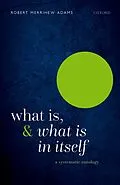This work is ''a systematic ontology.'' Ontology is the study of being as such, and a systematic ontology is an account of the most fundamental ways of being something or other - of what they are and of how they are related to each other. The questions it pursues are not primarily about what causes things, but about what things are or consist in - though causal questions cannot be totally avoided. The title of the work, What Is, and What Is in Itself, marks the most important distinction in ways of being. What is includes everything there is, but not everything there is included in what is in itself. The first five chapters of the book define and examine the ways of being: in chapters 1 and 2, being actual or existing, or even just being something without existing or being actual; in chapter 3, being an intentional object, and perhaps a merely intentional object; in chapter 4, relations between things and their properties; and in chapter 5, being a thing in itself. Chapter 6 discusses whether only conscious beings are things in themselves, and suggests an affirmative answer. Chapter 7 discusses the epistemology of ontology. Chapters 8 and 9 discuss issues about thisness and identity. And chapters 10 and 11 discuss mainly occasionalist and panentheist answers to questions about the causal unity of the universe.
Autorentext
Robert Merrihew Adams got an AB in philosophy at Princeton University, 1955-59, a BA in theology at Oxford University, 1959-61, and a BD at Princeton Theological Seminary, 1961-62, following which he served as pastor of a Presbyterian church in Montauk at the eastern tip of Long Island, 1962-65. He got his PhD in Philosophy at Cornell University, 1965-69. He then taught Philosophy full time at the University of Michigan, 1968-72, at UCLA 1972-93, and at Yale 1999-2003. He became a non-stipendiary Senior Research Fellow and very part-time Visiting Professor of Philosophy at Oxford University 2004-09, and a part-time Professor of Philosophy at UNC Chapel Hill 2009-13 and at Rutgers 2013-16.
Klappentext
This work is ''a systematic ontology.'' Ontology is the study of being as such, and a systematic ontology is an account of the most fundamental ways of being something or other - of what they are and of how they are related to each other. The questions it pursues are not primarily about what causes things, but about what things are or consist in - though causal questions cannot be totally avoided. The title of the work, What Is, and What Is in Itself, marks the most important distinction in ways of being. What is includes everything there is, but not everything there is included in what is in itself. The first five chapters of the book define and examine the ways of being: in chapters 1 and 2, being actual or existing, or even just being something without existing or being actual; in chapter 3, being an intentional object, and perhaps a merely intentional object; in chapter 4, relations between things and their properties; and in chapter 5, being a thing in itself. Chapter 6 discusses whether only conscious beings are things in themselves, and suggests an affirmative answer. Chapter 7 discusses the epistemology of ontology. Chapters 8 and 9 discuss issues about thisness and identity. And chapters 10 and 11 discuss mainly occasionalist and panentheist answers to questions about the causal unity of the universe.
